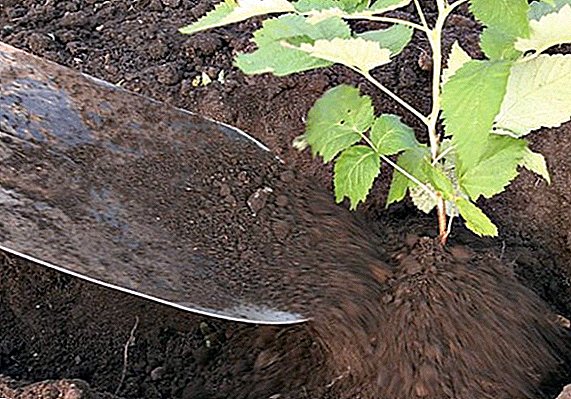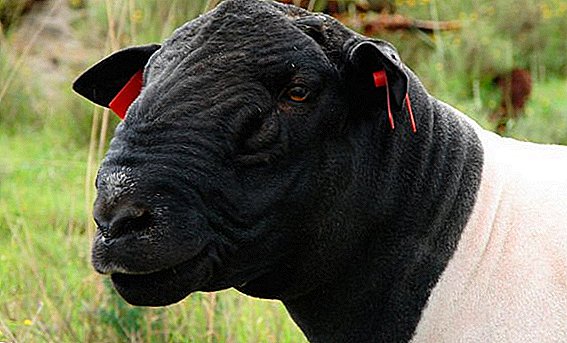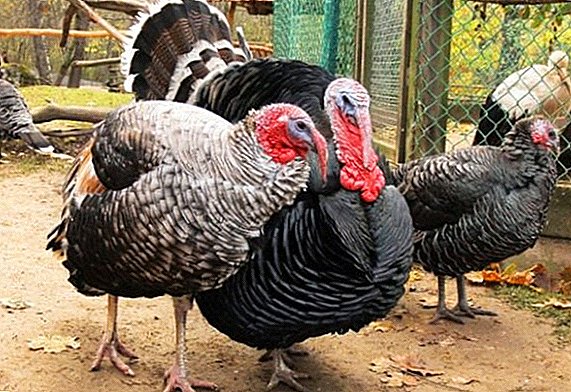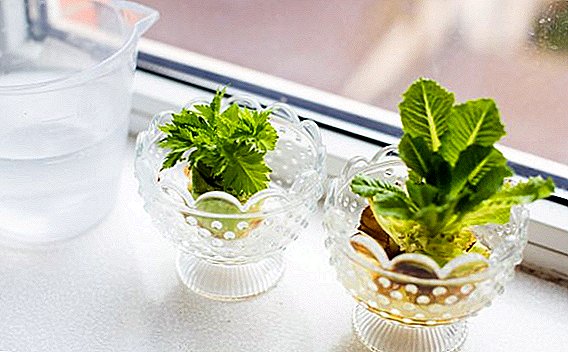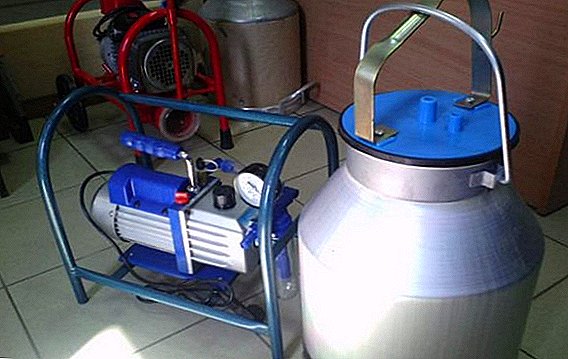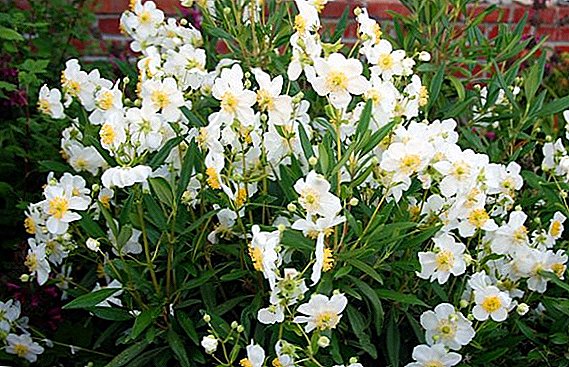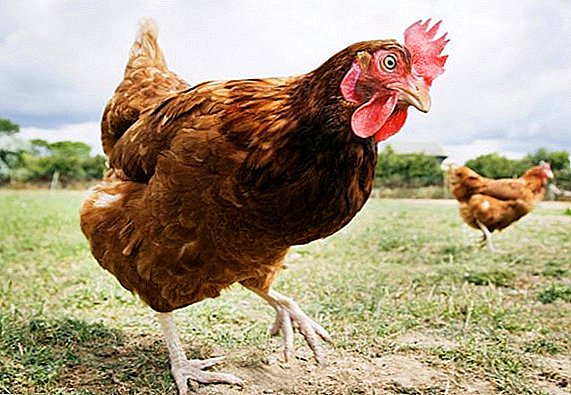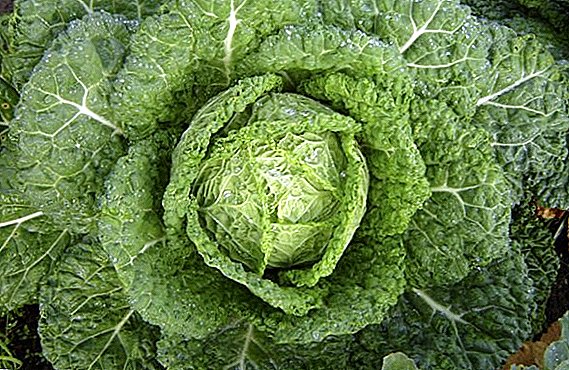 Unfortunately, exotic Savoy cabbage is not popular with our gardeners, because many tend to think that growing it is a difficult and time-consuming process. Is it really, we will tell in this article.
Unfortunately, exotic Savoy cabbage is not popular with our gardeners, because many tend to think that growing it is a difficult and time-consuming process. Is it really, we will tell in this article.
Characteristic and distinction of savoy cabbage
Savoy cabbage (Brassica oleracea convar. Capitata var. Sabauda), as well as its white cousin, comes from wild species originating from Western Europe and the territory of North Africa. It is actively cultivated in Europe, and is rarely found in the post-Soviet space, and mostly only in summer cottages.
Savoy cabbage is much tastier and more caloric than white cabbage. A head of cabbage is used for food, which contains a lot of useful elements:
- dry elements - 7-14%;
- sugar - 2-7%;
- crude protein - 2-4%;
- mineral salts - 0.84%;
- Vitamin C - 20-90 mg.
Did you know? Savoy cabbage is more valuable in its dietary qualities than white cabbage.

Growing savoy cabbage through seedlings
In general, there are no separate rules on how to grow Savoy cabbage at a dacha - agricultural technology is similar to growing white cabbage. It is usually cultivated through seedlings. If the seedlings are strong and healthy, then you can expect a good harvest.
When to sow on seedlings
Sowing time is determined by the cabbage variety. Early ripening varieties are planted in the second decade of March, mid-ripening - from mid-March to mid-April, late - in early April.
Climatic features are also taken into account during the cultivation of seedlings. From this directly depends on the time of planting seedlings on the beds. As a rule, this period is 30-50 days.
Soil for growing seedlings
For the Savoy cabbage harvest to be good, its biology must be taken into account. So, this type of cabbage differs in cold-resistance and light-loving, well tolerates moisture, however, it makes special demands on the soil.
In order for savoy cabbage in the open field to feel comfortable, the ground for planting must be soft, but not too loose. The main component of the soil - peat - should be present in the best quantity (at least 80%).  In addition, you need to add to the soil sand (about 5%) and sod land (20%). To improve the quality of seedlings and ensure good fertility, compost (humus mixture) is added to the ground. For every kilogram of soil mixture, it is desirable to add a spoonful of ash - it will serve as fertilizer and protection from the black leg.
In addition, you need to add to the soil sand (about 5%) and sod land (20%). To improve the quality of seedlings and ensure good fertility, compost (humus mixture) is added to the ground. For every kilogram of soil mixture, it is desirable to add a spoonful of ash - it will serve as fertilizer and protection from the black leg.
Important! You can not take land for seedlings from the site - there may be pests and infections that can be detrimental to young seedlings.
Presowing seed treatment
In order to disinfect the seeds of savoy cabbage, they are dipped in hot (50 ºC) water for 1/3 hour, and then in cold water for 2 minutes. After this, the seed samples are dried. This procedure will allow the seeds to germinate faster.
If the seeds are purchased from a reliable supplier, such a procedure is not necessary to carry out - the treatment most likely has already been carried out.  In order to increase the frost resistance of the crop, before planting the seeds of the Savoy cabbage for seedlings for a day, they are soaked in water with a temperature of +2 ºC. Germination of such seeds lasts up to three years.
In order to increase the frost resistance of the crop, before planting the seeds of the Savoy cabbage for seedlings for a day, they are soaked in water with a temperature of +2 ºC. Germination of such seeds lasts up to three years.
Important! The special color of the seeds sold in stores, says that they have undergone a course of preparation for planting.
Sowing seeds for seedlings
Many believe that if you properly prepare the soil and seeds, the result of planting will be amazing. However, this view is wrong. It is necessary to approach to sowing seriously, because it depends on how far the savoy cabbage will correspond to the description of the variety.
Seeds of savoy cabbage should be planted in 3 phases with a difference of 4 days. Seeds are planted in containers or individual cups to a depth of 1 cm.
Before and after sowing the land is watered abundantly until the emergence of seedlings. As soon as the seedlings come, watering should be reduced.
Conditions and care for crops
Properly grown seedlings - the key to a good harvest in the future. After the first shoots appeared (about 5 days later), they are thinned out so that the distance between them is 2 cm.
The key to strong seedlings is the right light. Light day for seedlings should be 14-15 hours. That is, before the time comes to dive down the Savoy cabbage, seedlings need to be organized for lighting. For this you can use a simple fluorescent lamp.  Water the seedlings should be regularly and in small portions, giving the top layer time to dry. Irrigation water temperature should be 2-3 degrees higher than the soil temperature. It is impossible to overdry or flood the ground - the soil should be steadily wet. After each watering, the ground should be slightly loosened so that water does not stagnate.
Water the seedlings should be regularly and in small portions, giving the top layer time to dry. Irrigation water temperature should be 2-3 degrees higher than the soil temperature. It is impossible to overdry or flood the ground - the soil should be steadily wet. After each watering, the ground should be slightly loosened so that water does not stagnate.
Important! Moisture stagnation can lead to the development of diseases and root decay.The optimum room temperature until the appearance of seedlings of Savoy cabbage is 18-20 ºC. After the shoots appear, the temperature regime must be changed: + 15-16 ºC during the day and + 8-10 ºC at night. Such a difference in temperature will exclude the saplings, will allow to harden the seedlings of Savoy cabbage and facilitate planting on the beds and caring for them in the future.
Like many cultures, sprouts of savoy cabbage need feeding. It is carried out in several stages:
- After picking - once a week. Ammonium nitrate (2 g), potash fertilizers and superphosphate (4 g) dissolved in a liter of water are used.
 This portion is enough for 50-70 seedlings.
This portion is enough for 50-70 seedlings. - 2 weeks after the picks. The elements are taken the same, only their concentration increases by 2 times.
- 2-4 days before planting in open ground. Potassium fertilizers (8 g), superphosphate (4-5 g), ammonium nitrate (3 g), diluted in a liter of water are used.
Important! In order to avoid burns, the soil must be watered before fertilizing.No less important is the hardening of seedlings. To this end, 8-10 days before planting on the site, it is necessary to carry out such operations:
- in the first two days it is enough for 3-5 hours to open the window in the room where the seedlings are cultivated;
- a few days you need to make seedlings on the street, covering with gauze from direct sunlight;
- on the 5-6th day, the frequency of watering should be reduced, but not allowed to dry out the soil, and put the seedlings outside for the entire time before planting.
Single Pot Dive
After 7-8 days, when the seedlings grow up and get stronger, they should be dived and seated in cassettes with a distance of 3 cm from each other. Deepen the seedlings to the cotyledons.  Good seedlings should have no more than five leaves. Weak, without the top kidney and fungus-affected seedlings are thrown away when picking.
Good seedlings should have no more than five leaves. Weak, without the top kidney and fungus-affected seedlings are thrown away when picking.
After another 2 weeks, seedlings should be transplanted into separate containers (cups) with pretreatment with a weak solution of blue vitriol. You can use another drug that will help protect seedlings from fungal diseases.
Did you know? You can grow seedlings without picks. In this case, the seeds are immediately planted in cups or small pots.
Planting seedlings of Savoy cabbage in open ground
Properly grown seedlings are not all you need to know about the cultivation of savoy cabbage. To obtain a decent crop, you must take into account the rules of its cultivation in the garden.
When to plant seedlings on the plot
 Savoy cabbage planted on the beds in May (given the climatic conditions, this period can be changed). For transplantation choose cloudy or evening.
Savoy cabbage planted on the beds in May (given the climatic conditions, this period can be changed). For transplantation choose cloudy or evening.
The seedling before planting on the beds should be 15-20 cm in height, dark green, have well-developed roots, not dried out stems and 4-7 leaves.
Place for savoy cabbage
Choosing the right place for cultivating savoy cabbage not only makes it easier to care for, but also allows you to get a good harvest.
Seedlings are best planted in areas where grain or legumes were previously grown. Saplings grow well on the ground where cucumbers, onions, potatoes, beets and tomatoes grew. You can not grow Savoy cabbage immediately after turnips, radishes, turnips, radishes, rutabaga, cress.
Important! It is not recommended to cultivate Savoy cabbage in one place for more than three years in a row.The best soil for this crop is that which is able to retain moisture for a long time (loamy, sandy, neutral, sod-podzolic). Not suitable for growing land with high clay content.
The place where the cabbage will grow should be well lit and be spacious.
The soil for planting is prepared in the fall: they plow deeply and introduce organic (compost, manure) and mineral (superphosphate, potassium chloride) fertilizers. In the spring, the earth is fed with ammonium nitrate to form a full-fledged head on the cabbage.
Important! Favorable soil for savoy cabbage should be weak acidity (5-5,8 pH). To reduce the acidity, lime is added to the soil every 3-4 years.
Process and landing scheme
 The area on which it is planned to plant the seedlings should be sprinkled with dry soil or organic compost (chopped weeds). They will help moisture linger in the ground, provide cabbage with nutrients, protect from weeds and the formation of earthy crusts.
The area on which it is planned to plant the seedlings should be sprinkled with dry soil or organic compost (chopped weeds). They will help moisture linger in the ground, provide cabbage with nutrients, protect from weeds and the formation of earthy crusts.
The wells for planting seedlings must be formed at a distance of 40 cm from each other. It is best to plant the seedlings in a staggered manner - this provides more space.
The depth of the hole should correspond to the height of the cup or the walls of the container in which the seedlings were growing. About one liter of water is poured into it and seedlings are planted. To the bottom of the leaflet seedlings sprinkled with soil.
At first, young cabbage should be protected from the sun (pritenyat).
Care and cultivation of savoy cabbage
Growing cabbage Savoy will not cause problems if you remember that such a plant loves moisture, loosening the soil, feed, light and space.
Watering, weeding, loosening and hilling
Savoy cabbage loves watering, but slugs also like moisture. Therefore, it is not recommended to irrigate this crop at the end of the growing season.
 After the heading out, watering by sprinkling or not on top is recommended. Watering should be carried out exclusively at the root. The ingress of moisture to the inflorescences can cause mucous bacteriosis, and the crop will be lost.
After the heading out, watering by sprinkling or not on top is recommended. Watering should be carried out exclusively at the root. The ingress of moisture to the inflorescences can cause mucous bacteriosis, and the crop will be lost.
During the dry period, it is desirable to humidify the air by sprinkling cabbage (every 15 minutes during the hot hours).
Do not forget about loosening when caring for Savoy cabbage - this process allows oxygen to better reach the roots. For the formation of lateral roots should be regularly hilling. And for good growth you need to clean the area from weeds.
Did you know? There is a proverb: cabbage loves water and good weather.
Fertilization
In order to harvest, which can boast to friends, the culture must be fed. Organic substances (manure, compost, humus) are used as a top dressing for savoy cabbage. Often fertilized with wood ash.
Feed made throughout the season:
- During landing. Then in a well add a teaspoon of ash and urea.
- 2 weeks after planting seedlings on the beds. If sowing was carried out immediately with seeds, top-dressing is best done after 3 weeks. For this purpose, mullein and urea are used, which are diluted in water (0.5 liters of mullein and 1 hour spoon of urea per 10 liters of water).
- 12 days after the last feeding. As fertilizer use 2 tbsp. spoons of nitroammofoski (NPK), diluted in 10 liters of water.
 The nitrogenous compounds in the soil directly affect cabbage growth, helping to gain vegetative mass and shape the head. About the lack of nitrogen say yellowed lower leaves, which die as a result. If you do not make fertilizer on time, you can forget about the harvest. Potassium deficiency affects the color of the leaves, which also begin to dry at the edges. Potassium deficiency is filled by potash fertilizers added to irrigation.
The nitrogenous compounds in the soil directly affect cabbage growth, helping to gain vegetative mass and shape the head. About the lack of nitrogen say yellowed lower leaves, which die as a result. If you do not make fertilizer on time, you can forget about the harvest. Potassium deficiency affects the color of the leaves, which also begin to dry at the edges. Potassium deficiency is filled by potash fertilizers added to irrigation.Important! You can not overfeed Savoy cabbage with phosphate fertilizers - it stimulates early flowering.
Treatment and protection from diseases and pests
Of course, diseases and pests (caterpillars, shovels, cabbage fly, fleas, aphids) do not contribute to a good harvest, so you should regularly inspect the Savoy cabbage for their appearance and immediately take measures to eliminate.
Chemical preparations cabbage is not recommended - It is better to cook the poison yourself, using the means at hand.
The most dangerous for savoy cabbage is excessive watering, which develops a disease such as "black leg". For treatment, you can fertilize the soil solution "Fundazola."
Cleaning and storage of savoy cabbage
 The first harvest of early varieties can be harvested in June, and the mid-season - in August. If savoy cabbage was grown for storage for the winter, its crop is harvested before frost. So better storage is provided. Savoy cabbage is stored somewhat worse than white cabbage, so it should be stored on shelves or in boxes, arranged in one row. To extend the shelf life, it is necessary to maintain a temperature of -1-3 ° C.
The first harvest of early varieties can be harvested in June, and the mid-season - in August. If savoy cabbage was grown for storage for the winter, its crop is harvested before frost. So better storage is provided. Savoy cabbage is stored somewhat worse than white cabbage, so it should be stored on shelves or in boxes, arranged in one row. To extend the shelf life, it is necessary to maintain a temperature of -1-3 ° C.
As you can see, the cultivation of savoy cabbage is not a difficult process. Simply familiarize yourself with the features of the plant, correctly cultivate the seedlings and produce regular care.


 This portion is enough for 50-70 seedlings.
This portion is enough for 50-70 seedlings.